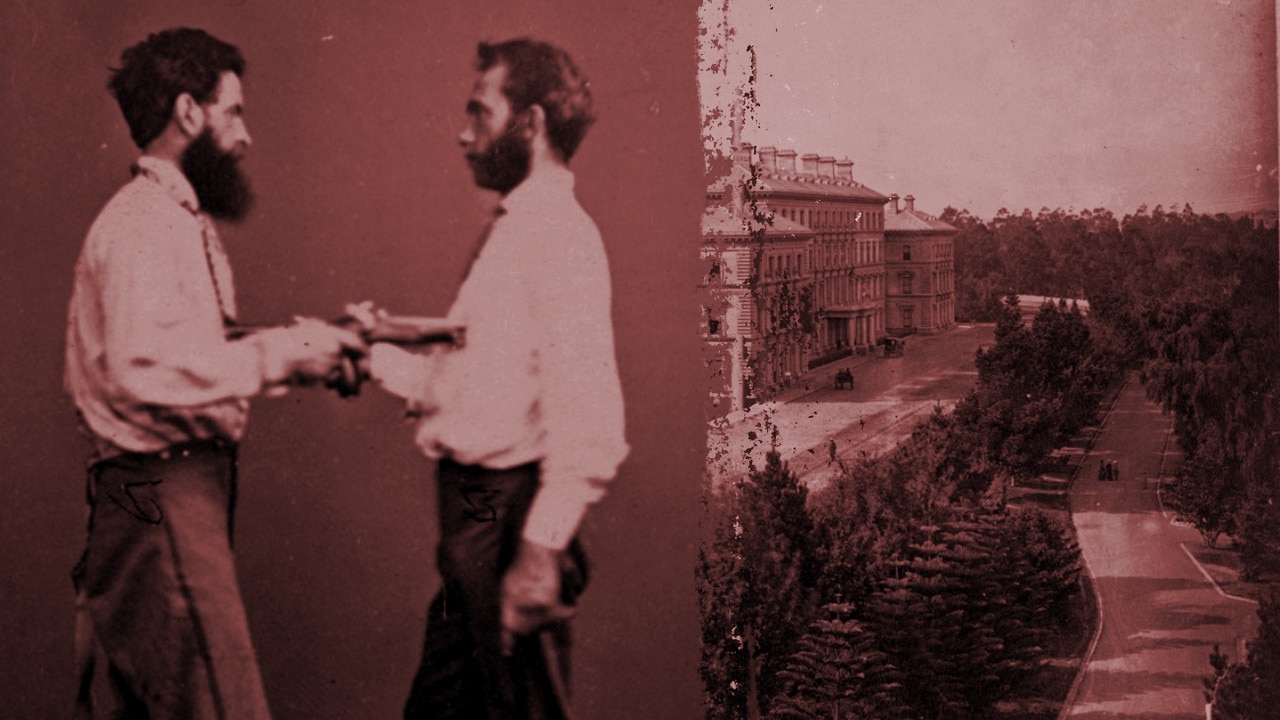Bushranger’s tombstone asks visitors to ponder morality of brutal death
An undercover cop sparked outrage when he gunned down a bushranger in cold blood in the town of Port Fairy. Now 160 years later, the question surrounding his brutal death is etched across his tombstone — did he deserve this?

About 5pm on February 12, 1859, James Harman was leaving town with his brother when they heard a gunshot.
Further up the road near the Catholic church a man was staggering towards a ditch.
A gun was in his hand. He’d been shot.
When Harman got closer another armed man had gotten off his horse.
“Look here, I have shot a man,” he said.
“I see you have,” said Harman.
The victim was now facedown on the dusty road and Harman turned him over.

The pistol in his hand was loaded but the man, a wanted bushranger, had breathed his last.
The shooter with the horse, who was calling for a doctor and clamping iron cuffs on a third scruffy man involved in the altercation, was a police officer.
But Harman noticed he wasn’t wearing his police uniform.
The shooting, and the inquiry that followed, would bring into question police tactics against bushrangers and result in the dead armed robber being placed in a forgotten grave with questions lingering for more than a century over his violent death.
HIGHWAY ROBBERY
The area now known as Port Fairy had been dangerous since the start.
Originally named Belfast by Irish settlers, it was used by whalers and sealers from 1828 as shelter from the infamous Shipwreck Coast, which claimed the lives of an untold number of seafarers during early colonisation.
By the 1840s squatters around Belfast were at war with aboriginal tribes and settlers wrote to Charles La Trobe requesting reinforcements.
By the late 1850s, after an uneasy peace with indigenous locals, another problem had emerged.
Bushrangers stalked the roads between Belfast and Portland, preying on anyone who passed.
On February 10, 1859, word reached Port Fairy that a pair of Portland residents had been robbed by two armed men, who stole cash and a valuable pocket watch.
Port Fairy police, including Constable Richard Wigmore, were sent to search the highways.

THE LONG MARCH
The following day, the net was closing on the bushrangers. Wigmore had heard two men fitting the offenders’ description had been seen in a nearby town.
Wigmore was ordered by Superintendent Charles Lydiard not to wear his police uniform as he went to apprehend them, in case it would scare the robbers away.
And, when Wigmore caught up with the pair on the road between Port Fairy and Portland, satisfied they were the culprits, he never declared he was a policeman.
Instead he told them to walk at gunpoint in front of his horse on the long road back to the Port Fairy barracks.
By the time they were approaching the village, near the Catholic church on the edge of town, one of the men decided to run for it.

Perhaps believing he was heading for a courtroom, perhaps believing he was simply falling victim to another bushranger, the man started to flee.
Wigmore attempted to block him with his horse but the man pulled out a pistol of his own and levelled it at Wigmore.
A shot rang out and the bushranger fell dead.
When the other robber, William Darcy, was later asked the dead man’s name, he said he had known him only as Dick.
No other records to verify the man’s identity were ever found. When he was searched, police found the missing cash and pocket watch.
SHOOT FIRST, ASK QUESTIONS LATER
The shooting caused a stir in the colony and many believed Dick had been wrongfully killed.
The decision not to wear a uniform, not to declare himself as a policeman and not search the bushrangers for weapons and evidence immediately put Wigmore in the spotlight.
Questions were also asked about why Superintendent Lydiard would send just one officer to apprehend two armed and violent men.

MORE MITCHELL TOY
A DAY IN THE LIFE OF AN NBN INSTALLER
THE REALITY SHOW MELBOURNE DESERVES
Outrage towards the police eventually ebbed.
Wigmore was exonerated in an inquiry and, ultimately, widely praised.
It was noted Wigmore had discharged his duty properly and members of a jury who heard the case were so supportive of the policeman, they all signed a letter recommending him for promotion.
It was also heard that Lydiard, having limited staff in the township, could not send more than one officer without creating undue risk in other areas.
William Darcy was sent to Pentridge Prison for his crimes.
Dick was buried in Port Fairy cemetery in a modest grave marked by stones and for more than a hundred years was forgotten.
In the 1990s a researcher located the spot and a memorial tombstone was erected.
Into it is carved: “Here lies Dick, bushranger. February 12th, 1859. Shot by police. Did he deserve this?”


